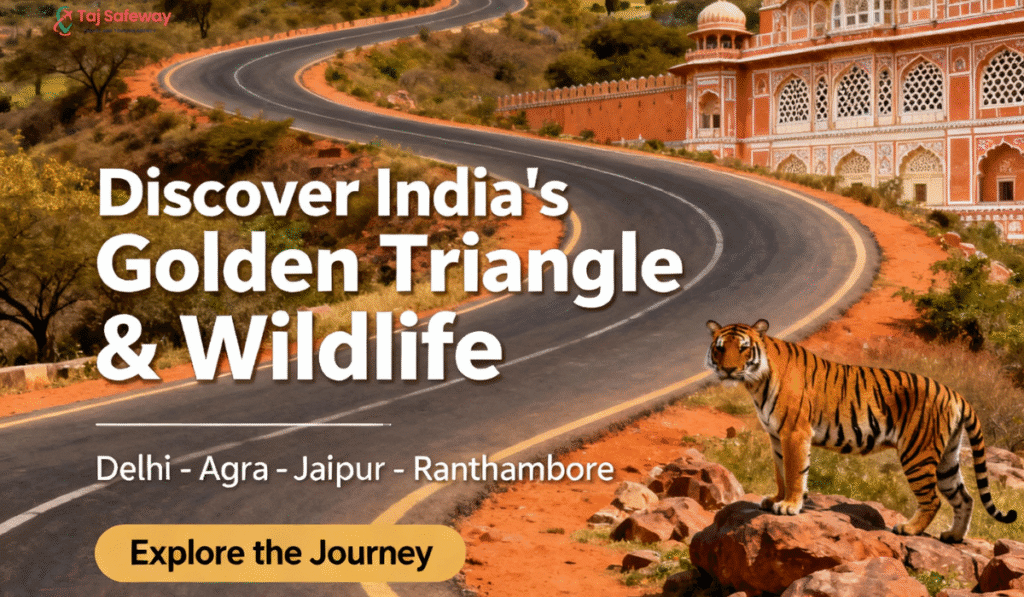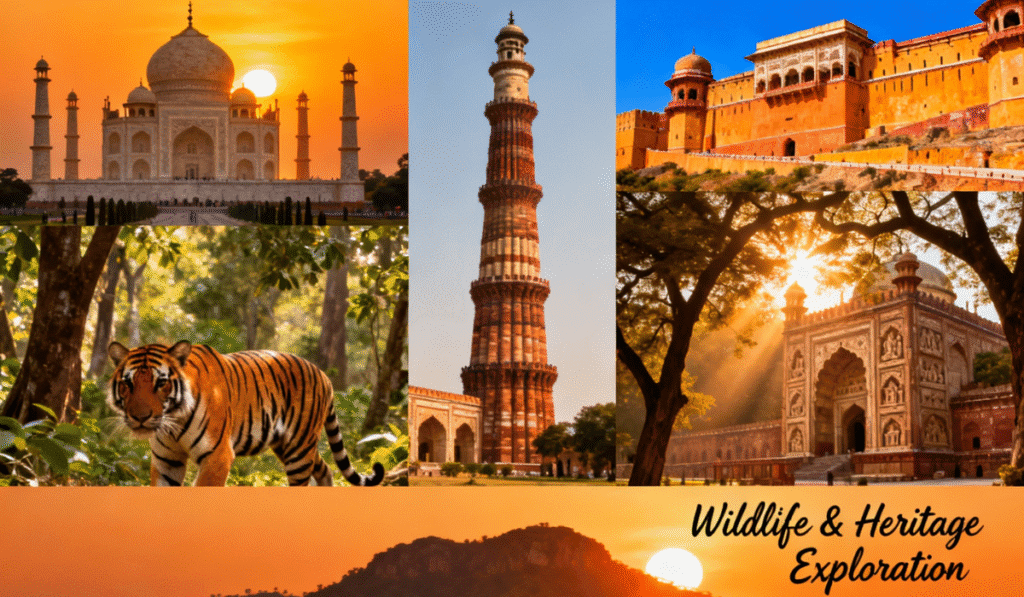When travelers think about exploring India for the first time, the Golden Triangle Tour comes to mind. This classic route connects Delhi, Agra, and Jaipur—three cities that showcase India’s royal past, Mughal architecture, and vibrant culture. From the majestic Red Fort in Delhi to the eternal beauty of the Taj Mahal in Agra and the grandeur of Amber Fort in Jaipur, this journey captures the essence of India’s heritage.
But what if you could enhance this cultural experience with an exciting wildlife adventure? That’s exactly what happens when you add Ranthambore National Park to your Golden Triangle Tour. Situated in Rajasthan, Ranthambore is one of India’s most famous tiger reserves and offers a chance to spot the majestic Bengal tiger in its natural habitat.
In this detailed guide, we’ll explore why the Golden Triangle Tour with Ranthambore is becoming one of the most popular choices for travelers worldwide.
Golden Triangle + Ranthambore: A Unique Combination

The Golden Triangle circuit already offers an incredible variety of attractions:
- Delhi – India’s capital, filled with a mix of modernity and Mughal-era monuments.
- Agra – Home to the Taj Mahal, Agra Fort, and Mughal gardens.
- Jaipur – Known as the “Pink City” for its palaces, forts, and royal heritage.
Adding Ranthambore to this route takes the journey to another level. While Delhi, Agra, and Jaipur highlight history, culture, and architecture, Ranthambore introduces travelers to wildlife safaris, lush jungles, and the thrill of tiger spotting. It is the perfect blend of heritage and adventure—something very few tours in India can offer.
Top Reasons to Add Ranthambore to Your Golden Triangle Tour
1. Thrilling Tiger Safaris
Ranthambore National Park is world-renowned for its tiger population. Unlike other reserves, Ranthambore’s tigers are often seen in daylight, offering higher chances of spotting them during safaris. Safari vehicles—either Gypsies (6-seater jeeps) or Canters (20-seater open buses)—take you deep inside the jungle. Imagine the excitement of watching a tiger walk along ancient ruins or rest beside a lake. For many travelers, this becomes the most unforgettable moment of their India trip.
2. Wildlife Beyond Tigers
While tigers are the main attraction, Ranthambore is also home to leopards, sloth bears, striped hyenas, marsh crocodiles, jackals, and wild boars. Birdwatchers can enjoy spotting crested serpent eagles, painted storks, kingfishers, and migratory species. The park’s rich biodiversity ensures that even if you miss a tiger, the safari is still rewarding.
3. Blend of History & Nature
One of Ranthambore’s unique features is the 10th-century Ranthambore Fort, a UNESCO World Heritage Site located inside the park. Standing tall on a hilltop, the fort offers panoramic views of the forest below. Exploring the fort after a safari gives travelers a rare chance to combine history with wilderness in one destination.
4. Luxury Jungle Resorts & Stay Options
Ranthambore is not just about safaris—it also offers a range of accommodations to suit every traveler. Luxury seekers can stay at The Oberoi Vanyavilas, Aman-i-Khas, or Taj Sawai Madhopur Lodge, while mid-range travelers can choose from comfortable jungle resorts and boutique hotels. These stays offer authentic Rajasthani hospitality, campfire evenings, and sometimes even guided nature walks.
5. Photography Paradise
From sunrise over the Taj Mahal to a tiger sighting at Ranthambore, the Golden Triangle with Ranthambore is a dream circuit for photographers. Landscapes, wildlife, ancient forts, and bustling bazaars give travelers endless opportunities to capture India’s diversity. Whether you’re a professional photographer or just carrying your smartphone, this tour guarantees memorable moments.
6. Perfect Balance of Culture and Adventure
Many travelers want more than just sightseeing—they want experiences. The Golden Triangle already offers a cultural deep dive, but with Ranthambore, it becomes well-rounded: history, culture, adventure, and nature in a single trip. Families enjoy the variety, honeymoon couples love the mix of romance and excitement, and solo travelers get both thrill and discovery.
Suggested 7-Day Itinerary for Golden Triangle Tour with Ranthambore
Here’s a sample itinerary that balances sightseeing and safaris:
- Day 1: Delhi – Arrive in Delhi. Visit Red Fort, India Gate, Qutub Minar and Humayun’s Tomb.
- Day 2: Delhi to Agra – Drive to Agra. Explore the Taj Mahal, Agra Fort, and Mehtab Bagh (sunset view of Taj).
- Day 3: Agra to Ranthambore (via Fatehpur Sikri) – Stop at the deserted Mughal capital, Fatehpur Sikri, before reaching Ranthambore.
- Day 4: Ranthambore – Morning and evening safaris. Optional visit to Ranthambore Fort.
- Day 5: Ranthambore to Jaipur – Drive to Jaipur. Evening free for shopping or cultural shows.
- Day 6: Jaipur – Explore Amber Fort, City Palace, Hawa Mahal, Jantar Mantar, and local bazaars.
- Day 7: Jaipur to Delhi – Return to Delhi for departure.
This itinerary can be extended to 8–10 days if travelers want slower exploration or extra safari drives.
Best Time to Visit Ranthambore
- October to April – Pleasant weather, good tiger sightings, best time for tourists.
- May–June (Summer) – Hot, but high chances of seeing tigers near waterholes.
- July–September (Monsoon) – Park closed for safaris, though buffer zones may remain open.
Travelers should plan their Golden Triangle with Ranthambore between October and March for the best experience.

Travel Tips for Golden Triangle Tour with Ranthambore
- Book Safaris Early – Safari permits often sell out weeks in advance.
- Choose Safari Type – Opt for a Gypsy if you prefer small groups, Canter for budget or larger groups.
- Pack Smart – Light cotton clothes for summer, woolens for winter mornings.
- Respect Rules – No feeding animals, no loud noise, no littering.
- Stay Near Park Gates – Resorts near entry zones save travel time for early morning safaris.
- Carry Binoculars & Camera – For better wildlife spotting and photography
Frequently Asked Questions (FAQs)
1. What is the Golden Triangle Tour with Ranthambore?
It is a travel circuit covering Delhi, Agra, Jaipur, and Ranthambore National Park. It combines cultural sightseeing with wildlife safaris.
2. How many days are needed for the Golden Triangle with Ranthambore tour?
A 6–8 day trip is ideal to cover all destinations and enjoy at least two safaris.
3. What is the best time to visit Ranthambore on a Golden Triangle Tour?
The best season is October to April when the weather is pleasant and wildlife sightings are high.
4. Can I spot tigers easily in Ranthambore?
While tiger sightings are not guaranteed, Ranthambore is one of India’s best reserves with frequent sightings.
5. What are the safari options in Ranthambore?
Travelers can choose between Gypsy (6-seater jeeps) or Canter (20-seater open buses). Both have trained guides.
6. Is Ranthambore safe for tourists?
Yes, safaris are conducted under strict safety rules. Just follow the guide’s instructions.
7. How can I include Ranthambore in my Golden Triangle Tour itinerary?
Most itineraries place Ranthambore between Agra and Jaipur, making travel smoother.
8. What type of accommodation is available in Ranthambore?
From luxury resorts like The Oberoi Vanyavilas to mid-range lodges and budget hotels, Ranthambore has something for every traveler.
Conclusion
The Golden Triangle Tour with Ranthambore is the ultimate Indian travel experience. While the Taj Mahal, Amber Fort, and Jaipur’s palaces immerse you in India’s royal history, Ranthambore adds the thrill of tiger safaris and jungle adventures. This combination creates a well-rounded journey of culture, heritage, wildlife, and luxury—perfect for first-time visitors as well as repeat travelers looking for something unique.
If you’re planning to explore India, don’t just stop at the Golden Triangle. Add Ranthambore National Park and turn your trip into a memorable adventure of history and wildlife.






